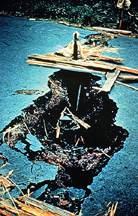

  |
Volcanic Hazards Earthquakes around volcanoes are caused by movement of lava inside the volcano. The lava
literally pushes rock aside as it moves underground. The rock is brittle and breaks as it
is moved, releasing seismic energy that we record as earthquakes. Most of the earthquakes
are small to medium in size. When they occur in large groups during a short period of
time, they are called swarms. These occur often and can keep the ground continuously
shaking for long periods of time. Some earthquakes can be large, such as the 5.1-magnitude
earthquake that started the May 18 eruption of Mount St. Helens, which was the result of
the north half of the mountain breaking free. Photo: Courtesy of NGDC/NOAA Earthquakes around volcanoes are caused by movement of lava inside the volcano. The lava
literally pushes rock aside as it moves underground. The rock is brittle and breaks as it
is moved, releasing seismic energy that we record as earthquakes. Most of the earthquakes
are small to medium in size. When they occur in large groups during a short period of
time, they are called swarms. These occur often and can keep the ground continuously
shaking for long periods of time. Some earthquakes can be large, such as the 5.1-magnitude
earthquake that started the May 18 eruption of Mount St. Helens, which was the result of
the north half of the mountain breaking free. Photo: Courtesy of NGDC/NOAATidal waves are giant water waves that form when volcanoes erupt in or near large bodies of water. Waves can be caused by large earthquakes associated with the volcano, by movement of seafloor rocks during caldera eruptions, by giant rock avalanches, or by boiling or expulsing water out of a hot, collapsed crater. Poison gases are released in and around volcanoes before, during, and for many years after volcanic eruptions. The most abundant gases released by volcanoes are water vapor and carbon dioxide, which are not directly poisonous. However, many of the less abundant volcanic gases are definitely not recommended for breathing, such as (in order of decreasing abundance) sulfur dioxide (SO2) and sulfur trioxide (SO3)--which are nasty enough by themselves, but combined with the abundant water form sulfuric acid--hydrochloric acid (HCl), carbon monoxide (CO), hydrofluoric acid (HF), boric acid (H3BO3), etc. These gases are released by eruptions but also percolate up from underground masses of lava to the surface. Where the gases vent through dry rock, fumaroles form. Where the gases vent into the lakes that often form in volcanic craters, poisonous lakes develop. One lake in Indonesia has been converted to a huge basin of concentrated sulfuric acid. Lake Nylos, a lake in a volcanic crater in Cameroon, Africa, became saturated with carbon dioxide. In 1986 a disturbance in the lake caused about a cubic kilometer of heavy CO2 gas to bubble to the surface and flow down a nearby valley like the CO2 mist used on monster movie sets. The gas settled over a village in a low-lying spot for a short time before dispersing, asphyxiating more than 1,700 villagers and all their animals.
[ Volcanoes & Climate ] [ Monitoring Volcanoes ] [ Home ] [ Teacher Pages ] [ Modules & Activities ] |
HTML code by Chris Kreger
Maintained by ETE Team
Last updated September 29, 2010
Discuss Exploring the Environment!
Some images © 2004 www.clipart.com.
Privacy Statement and Copyright © 1997-2004 by Wheeling Jesuit University/NASA-supported Classroom of the Future. All rights reserved.
Center for Educational Technologies, Circuit Board/Apple graphic logo, and COTF Classroom of the Future logo are registered trademarks of Wheeling Jesuit University.